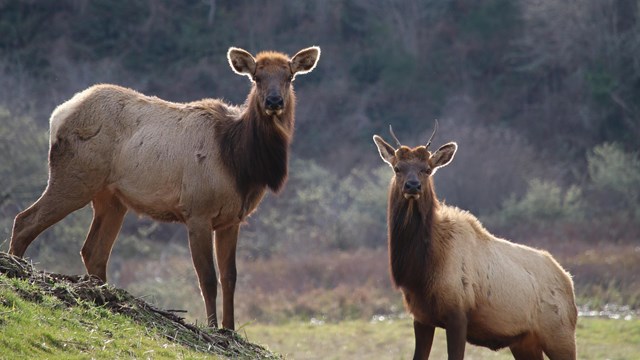
NPS / Kayla Fermin Clatsop and Lower Chinook peoples have long observed, understood, and cared for their homelands at the mouth of the Columbia River. But to the Corps of Discovery, the landscape revealed where the river met the sea was vibrant, diverse—and largely unknown. Tidal marshes, estuarine mudflats, and coastal dunes rose up to meet a fog-shrouded, coniferous rainforest with towering Sitka spruce six feet in diameter. Lewis and Clark, both skilled amateur naturalists, filled expedition journals with their efforts to observe and catalogue their surroundings. These records form part of the continuing work to understand and protect these increasingly rare ecosystems. Today as always, stewardship requires knowledge of a place. In a time when areas around the park are being shaped by ongoing development and timber harvest, the park itself is confronting rising temperatures, changing seas, and biological newcomers like purple loosestrife. All this leads scientists to ask: What changes are we observing? How much change is normal? Like a doctor tracking a patient’s pulse, National Park Service scientists monitor ecological “vital signs” in Lewis and Clark National Historical Park and throughout the North Coast & Cascades Network. Sensitive ecological indicators monitored in the park include intertidal communities, elk populations, water quality, and others. Park scientists also conduct a wide range of research in collaboration with tribal, state, and federal agencies; universities; and other park partners. Plant and animal inventories, community science to monitor mercury in ponds and lakes, and sound-based studies of bats and migratory birds all help us better understand the park—how to care for it. Stewardship and conservation work builds on this foundation of knowledge. Park staff are actively removing invasive plants, restoring forests degraded by timber harvest, and reconnecting floodplains for endangered salmon habitat—all while monitoring the effectiveness of these restoration efforts. As we move into a future beyond historical climate norms, scientific study will continue to give us the tools to be informed stewards of this diverse and complex place. 
Elk Monitoring
Long-term monitoring of the Roosevelt elk is essential to preserving the historical, cultural, and natural character of Lewis and Clark NHP. 
Bioacoustics Monitoring
Sound matters. Learn about soundscapes and the bioacoustic studies that help us understand the park's bats and migratory birds. 
Dragonfly Mercury Project
The park participates in the national Dragonfly Mercury Project to understand mercury pollution risks within national parks. 
Tidal Wetland Restoration
Learn how the park is contributing to the recovery of the Youngs Bay watershed and endangered salmon populations. 
Water Quality Monitoring
Clean water is crucial for the health of salmon and other aquatic life. The park and partners monitor the status of our rivers and streams. 
Forest Restoration
In 2002, 963 acres of former timber lands were added to the park. Learn how managers are restoring this rare coastal temperature rainforest. Published Science Reports
Lewis and Clark Climate Futures Summary
Temperatures are currently rising in Lewis and Clark at 2.3°F per century. This 2024 report outlines what climate futures mean for the park. 
Natural Resource Condition Assessment
This 2020 report details the status and trends of Lewis and Clark's natural resources—from lampreys to night skies to coastal forests. The NPS DataStore archives studies and reports by park scientists or produced in collaboration with the NPS. Some reports below are part of the NPS Natural Resource Report Series or Science Report Series and are only published in the DataStore. Explore scientific journals and databases to find studies by researchers unaffiliated with the park. Source: NPS DataStore Saved Search 5325 (results presented are a subset). To search for additional information, visit the NPS DataStore. Park Species ListSelect a Park:Select a Species Category (optional):
Search results will be displayed here.

North Coast & Cascades Network
Learn how long-term ecological monitoring is used to track the health of Lewis and Clark and national parks across the Pacific Northwest. 
North Coast & Cascades Science Days 2025
Join us for a three-day virtual symposium in February featuring science that spans parks, ecosystems, and fields of study. 
Conduct Research in the Park
A permit is required for most scientific research activities in the park. Learn more and apply here. |
Last updated: November 5, 2024
